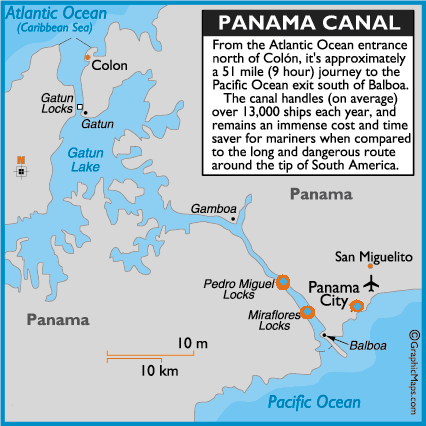Overview:
The history of the Panama Canal is fascinating. In the 1880s, Colombia
made a treaty with France for the construction of a canal across
Panama's narrow isthmus, but yellow fever claimed the lives of more than
22,000 workers over a five-year period, and construction was halted.
Over Colombia's objections, one of the French investors negotiated a
deal to have the United States construct a canal just at the time that
Panama's independence movement needed tactical and financial assistance.
When Panama declared its independence from Colombia in November 1903,
U.S. troops were already present to "protect" the new government. In
return for constructing a canal, the new Panamanian government granted
U.S. control over rights on either side of the canal "in perpetuity,"
and U.S. president Theodore Roosevelt's "Panama Doctrine" began with the
eradication of mosquitoes, which carried malaria and yellow fever. The
Panama Canal was completed in 1914 and has remained an important
shipping route ever since. In 1921, the United States paid Colombia
US$25 million in exchange for revoking all claims on Panama, and in
1936, the United States finally gave up the legal right to use its
troops outside the borders of the Canal Zone. With the onset of World
War II, the canal became one of America's most valuable strategic assets
and was heavily protected by fleets of U.S. warships.
This
is the first set of locks situated on the Pacific entrance of
the Panama Canal. The locomotives maneuver the ships through the
locks prior to being raised or lowered 27 feet per chamber.
Twenty six million gallons of water is transferred in only 7
minutes and all done by gravity. Your bath tub doesn't drain
that fast.
There are three sets of
locks in the Panama Canal. On the Pacific entrance are
Miraflores, with two chambers, and Pedro Miquel with one
chamber. On the Atlantic is one set of locks with 3 chambers,
the Gatun Locks. Ships are raised a total of 87 feet above sea
level into Gatun Lake and then lowered at the end of their
transit into the other ocean. A common misconception is that one
ocean is higher that the other, but they are both at sea level.
Panama receives as much
as 200 inches of rain per year. This was a determining factor in
placing the canal there since 52 million gallons of fresh water
is lost to the ocean on each transit.
Panama is
situated just a few degrees from the equator. The climate is
quite warm and humid with the humidity always high, around 80
percent.
Building the Canal:
The Panama Canal
extends across the Isthmus of Panama from Colon on the Atlantic
Ocean (Caribbean Sea) side, to Balboa and the
Pacific Ocean.
It was built in two
stages; 1881-1888 by the French, followed by the Americans, with
their efforts completed in 1914. In 1883 it was realized that
the tide level at the Pacific side was almost 19 feet higher
than the Atlantic side. Engineers concluded the difference in
levels would be a danger to navigation. It was proposed that a
tidal lock be constructed near Panama City to
preserve the level from there to Colon.
Eventually, due to some
new thinking, and in an effort to do it right the first time, it
was decided that the original plan should be modified and a
widely accepted lock system should be used. As an
example, when a ship traveling from the Atlantic side reaches
the Gatun Locks, a series of three locks raise that ship about
85 ft. to Gatun Lake. Then it's a 40 mile trip to the locks at
Pedro Miguel, locks that lower the ship 30 feet. At the
Miraflores locks the ship is lowered an additional 52 feet to
Pacific Ocean sea level.
During the invasion of
Panama by the United States in 1989, in their
successful effort to remove the de facto ruler General
Manuel Noriega from office, the canal was closed for the first
time in its history. Managed for decades by the U. S. A., the
canal was returned to Panama on December 31, 1999. |





